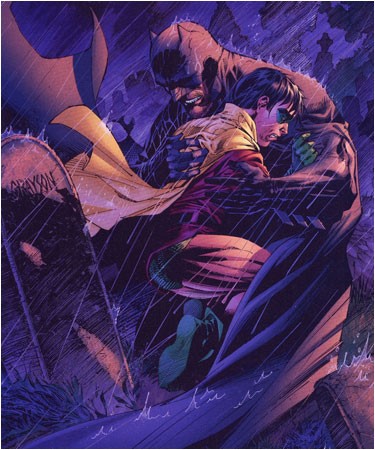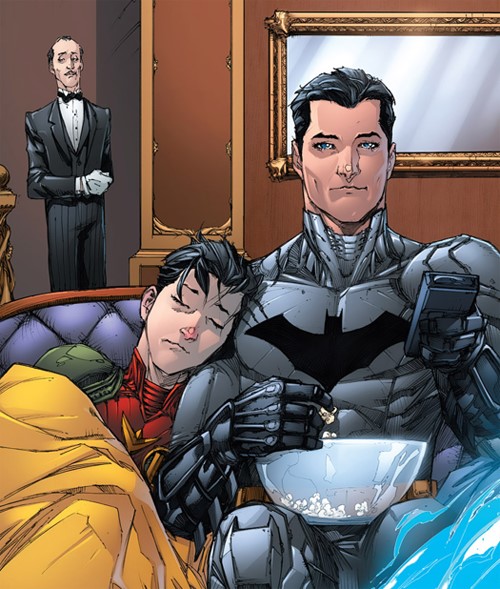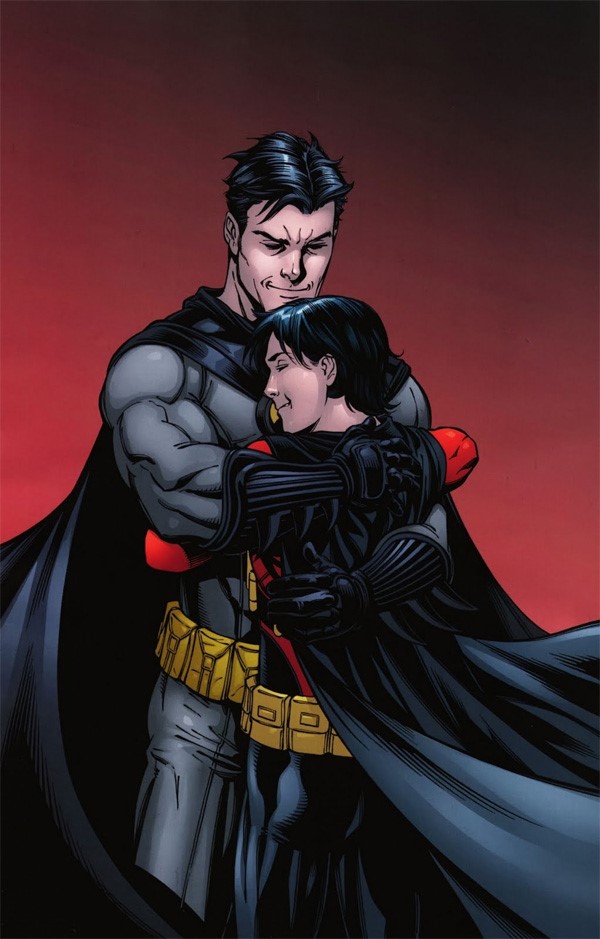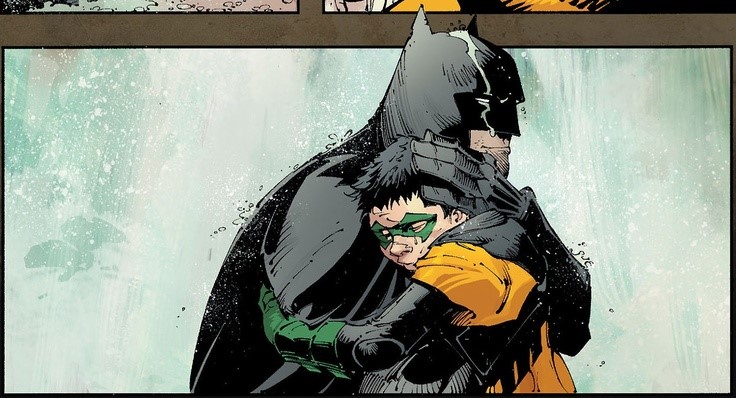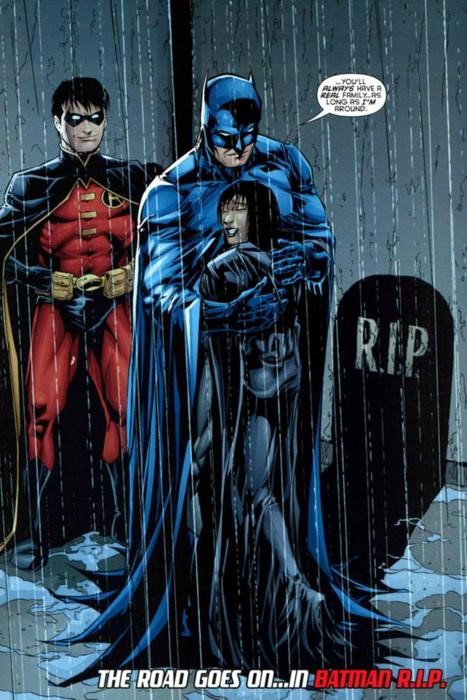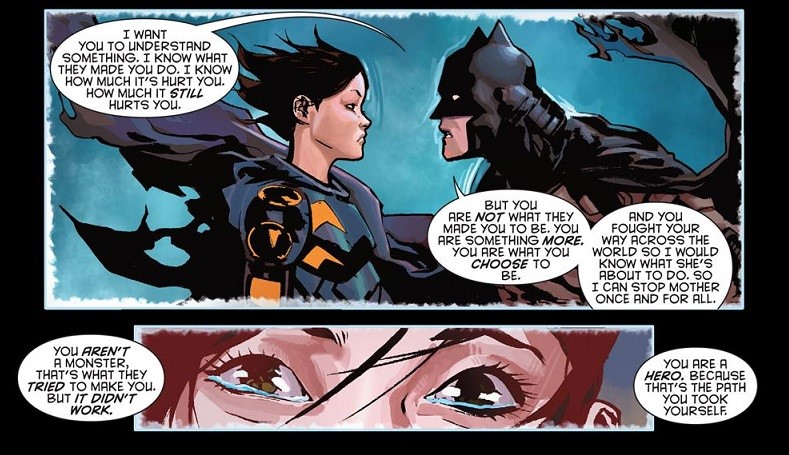 The second mid-season finale of CW’s “The Flash” ends on a cliffhanger with Joe and Iris West meeting their long lost son/brother Wallace for the first time. It’s a big moment for the show, in a scene that while affecting Barry Allen – the West’s adopted son, concentrates more on the immediate shock of the blood-related family members. The attention towards the West’s surprise however served more as byproduct for the sake of a greater ambition. For fans of the Flash comics, the lead-up to revealing Wally relayed the sense of importance and affection the character enjoys in comic book fandom. In anticipating his first appearance, the audience is given ample moments to realize that this will be an important character for the series. For fans of the comics, it works more as shorthand to say “Don’t worry, we know exactly how much Wally means to you and will have it so that everyone else will feel the same way.”
The second mid-season finale of CW’s “The Flash” ends on a cliffhanger with Joe and Iris West meeting their long lost son/brother Wallace for the first time. It’s a big moment for the show, in a scene that while affecting Barry Allen – the West’s adopted son, concentrates more on the immediate shock of the blood-related family members. The attention towards the West’s surprise however served more as byproduct for the sake of a greater ambition. For fans of the Flash comics, the lead-up to revealing Wally relayed the sense of importance and affection the character enjoys in comic book fandom. In anticipating his first appearance, the audience is given ample moments to realize that this will be an important character for the series. For fans of the comics, it works more as shorthand to say “Don’t worry, we know exactly how much Wally means to you and will have it so that everyone else will feel the same way.”
It’s harder to achieve that effect in comic books. In returning a fan-favorite to the forefront of the stories, the nature of the reboot has it so where it can’t spend as much time reintroducing an old character as it can introducing a new one. The audience either knows what to expect or will have online access available to figure out in broad strokes what’s coming. So the only thing that can sustain a rebooted character’s introduction is the framing in which necessitates the character’s existence. The story must facilitate the player’s existence, as fanservice cannot be raison d’etre enough.
So when it comes to Batman and Robin Eternal, the questions becomes “what is the story about, and how does it facilitate the revival of Cassandra Cain?” Well there are a few answers to that.
- The story is about history and how the history of Batman and Robin was borne out of deceit and betrayal from almost the very start.
- The story is about partners and how the various partners of Batman (Dick Grayson, Jason Todd and Tim Drake) reflect on the character of their mentor and seek to learn the truth about secrets he kept from them, all while forming partnerships with the new generation of young heroes on their own.
- The story is about family and how the Bat-Team (or, Bat-Family) works to correct the mistakes of their mentor despite repeating them, with lying and deception a recurring mode of operation on the part of Dick Grayson. Family as theme is also sub textually referred to throughout with the villain of the story being called “Mother”.
 With these three potential points, the attraction for the longtime Batman fan will be in seeing the interactions of the sidekicks. And yet two problems occur. First is the weekly format of the Eternal storyline which prohibits much character interplay beyond basic fight scenes and info dumps. The chances for meaningful interaction between the Bat-Family for the sake of it are limited. Second is the fact that in considering those three points, the central theme for the storyline seems to be distrust.
With these three potential points, the attraction for the longtime Batman fan will be in seeing the interactions of the sidekicks. And yet two problems occur. First is the weekly format of the Eternal storyline which prohibits much character interplay beyond basic fight scenes and info dumps. The chances for meaningful interaction between the Bat-Family for the sake of it are limited. Second is the fact that in considering those three points, the central theme for the storyline seems to be distrust.
This theme is popular in the new 52, and it’s one that I’ve often complained about on the Comic Cast. It presents itself as a tool for dramatic storytelling, but quickly reels into melodrama and doesn’t explore anything about the relationships beyond the fact that they’re apparently very fragile. The fact that the Bat-Family’s trust in Batman is repeatedly shattered by whatever new event occurs serves only to abort chances for those relationships to blossom, as we’ve never seen them be developed for this continuity. We’ve never seen an adventure with Bruce and Tim or Bruce and Jason so the only thing these betrayals can go after is our memories of the previous era. Bruce and Dick’s partnership especially takes a beating in this storyline, as it sets up the fact that Bruce wasn’t being truthful or trusting towards Dick from the very beginning. In a reality where Bruce and Dick’s relationship has been shaky since the late eighties, this idea functions to destroy what many people still see as the premiere Batman and Robin team. Mistrust between the two starts to validate the notion that the Dynamic Duo were never interesting or valuable enough to exist as individual characters amicably, and further compounds on the incessant theory that Robin as a concept doesn’t work within the Batman rubric. I don’t think that was the writers’ intention, but the idea’s repetition (a result of lackadaisical focus from the editors) infers that DC Comics agrees with those less kind Batman fans.
 Moreover, the flashback sequences with Batman and Robin oddly center on Dick’s fears of inadequacy. “Being a better Robin” is a refrain from Dick’s mouth which doesn’t fit his character. With Jason and Tim sure, but Dick was the trendsetter. Robin was an identity meant for him and his pain, not just to help out Batman. Everyone that followed just went after the mantle because of the Batman and Robin tradition/the Warner Bros. marketing department. It’s a misread of the character and dynamic which I suppose doesn’t contradict Jim Lee’s glib remark about the “Robin” position being a two year stint. But taking into account how seriously the Robin concept is treated in We Are Robin and how the role is repeatedly referred to with admiration by the characters in that book, there’s a contradiction in how Batman and Robin Eternal perceives it in its exploration of the other characters. Robin becomes a larger-than-life ideal that eclipses the identity of those in the mantle, past, present and future. That’s…wrong.
Moreover, the flashback sequences with Batman and Robin oddly center on Dick’s fears of inadequacy. “Being a better Robin” is a refrain from Dick’s mouth which doesn’t fit his character. With Jason and Tim sure, but Dick was the trendsetter. Robin was an identity meant for him and his pain, not just to help out Batman. Everyone that followed just went after the mantle because of the Batman and Robin tradition/the Warner Bros. marketing department. It’s a misread of the character and dynamic which I suppose doesn’t contradict Jim Lee’s glib remark about the “Robin” position being a two year stint. But taking into account how seriously the Robin concept is treated in We Are Robin and how the role is repeatedly referred to with admiration by the characters in that book, there’s a contradiction in how Batman and Robin Eternal perceives it in its exploration of the other characters. Robin becomes a larger-than-life ideal that eclipses the identity of those in the mantle, past, present and future. That’s…wrong.
There are silver linings within these circumstances. With such a damning indictment of Batman’s character implied to have existed for years (his involvement with murder), the story justifies involving every erstwhile partner. It’s pretty cool having all these characters together on a weekly basis, even if there’s not much going on with them. Jason and Tim have become a veritable double act for the series, with Jason’s characterization at its all-time thinnest. He spouts off stock dialogue about hitting up bars and calls Tim “nerd”; at what point did Jason Todd become the frat boy of the Bat-Family? Tim’s marginally better, but the new 52 iteration still characterizes him as a genius and a showoff, two non-aspects to his character that appeared out of nowhere. I suppose with the truncated timeline Tim’s original character was too subtle to merely explain in a single sentence, so they opted to decay his ego in order to describe him. But wouldn’t that make him too much like Dick, Jason and Damian – Robins who all had big egos to being with?
Harper Row and Stephanie Brown’s personas are turned up as well, although I admit to chuckling at Steph’s “Kiss me sexy Batman” line. Harper spouts off dialogue about her being a thief, which seems like the writers saying “Ya see that’s why she has a Mohawk.” It’s interesting seeing a relationship develop between her and Cassandra, although I wish Stephanie Brown wasn’t being left in the lurch so the three of them could interact. It’s surface level exploration with varying levels of payoff.
 So when it comes to Cassandra her presentation is good enough, although the book makes me nervous every time she interacts with someone. With someone like Cassandra Cain, the uncaring writer risks presenting her character flaws to the point of racial exploitation. A female Asian character that cannot speak, read or write but is amazing at martial arts is a very problematic archetype that requires a delicate touch. Those elements are present for her character in this story, but her actual personality has up to this point been almost non-existent, characterized mainly by how useful she is to other people. It’s not a million miles from her introduction in No Man’s Land, where Batman immediately suited her up as Batgirl the near-instant he learns her backstory. The difference with her first introduction and this new one is in the pacing of presentation.
So when it comes to Cassandra her presentation is good enough, although the book makes me nervous every time she interacts with someone. With someone like Cassandra Cain, the uncaring writer risks presenting her character flaws to the point of racial exploitation. A female Asian character that cannot speak, read or write but is amazing at martial arts is a very problematic archetype that requires a delicate touch. Those elements are present for her character in this story, but her actual personality has up to this point been almost non-existent, characterized mainly by how useful she is to other people. It’s not a million miles from her introduction in No Man’s Land, where Batman immediately suited her up as Batgirl the near-instant he learns her backstory. The difference with her first introduction and this new one is in the pacing of presentation.
In Batman #567 we’re introduced to Cass as Oracle’s unassuming courier who Babs is teaching how to read. We’re soon shown her heroism when she interrupts David Cain’s assassination attempt on Commissioner Gordon (at the behest of Two-Face) to the point of self-sacrifice, and after saving her life Batman quickly surmises her fighting skills, tutelage under Cain and absence of verbal communication skills.
 It’s a relatively speedy introduction that occurs in two issues, yet the pacing and storytelling skills are second-to-none (these were penned and illustrated by Kelley Puckett and Damion Scott, the team that did the bulk of Cassandra’s subsequent ongoing title). We learn everything there is to know about Cassandra at this point, and it’s easy to see why she became a new supporting character. Her interactions with Batman, Oracle and David Cain in her first appearance set the stage for dramatic heft from three characters representing three elements of the Batman comics (Batman, supporting players, major bad guy), and this develops further in her series the following year.
It’s a relatively speedy introduction that occurs in two issues, yet the pacing and storytelling skills are second-to-none (these were penned and illustrated by Kelley Puckett and Damion Scott, the team that did the bulk of Cassandra’s subsequent ongoing title). We learn everything there is to know about Cassandra at this point, and it’s easy to see why she became a new supporting character. Her interactions with Batman, Oracle and David Cain in her first appearance set the stage for dramatic heft from three characters representing three elements of the Batman comics (Batman, supporting players, major bad guy), and this develops further in her series the following year.
Batman and Robin Eternal introduces her in the first issue, after establishing the many characters set to be involved in the story (Dick Grayson, Jason Todd, Tim Drake, Spyral, Harper Row). She runs into Dick and beats him up, demonstrating to him and the readers her body language reading skill-set. She gives him a flash drive which he plugs into the Bat Computer, and it’s revealed that she’s been working with Batman. She then saves Harper Row from “Orphan”, joins up with the rest of the Bat-Family and primarily works with Harper and Dick in figuring out Mother’s connection to Batman.
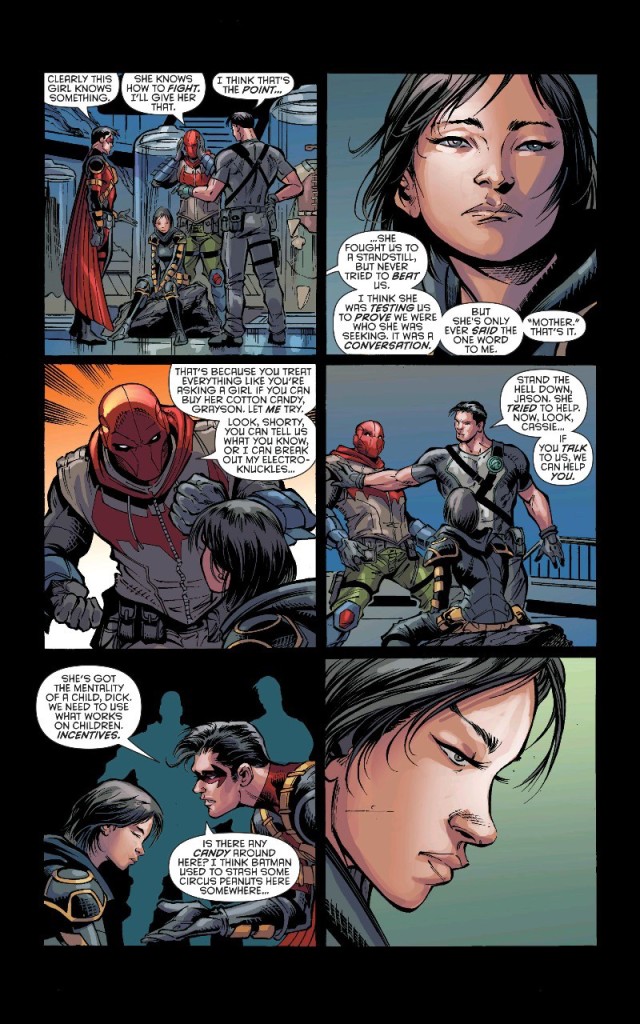 The necessary beats are reintroduced here but, when comparing with the original version, the nuances in this version are suppressed in order to keep the story moving. Cassandra’s lack in speaking skills and her fighting skills are all one takes away from her in most of the first several issues of this title.
The necessary beats are reintroduced here but, when comparing with the original version, the nuances in this version are suppressed in order to keep the story moving. Cassandra’s lack in speaking skills and her fighting skills are all one takes away from her in most of the first several issues of this title.
Comparing and contrasting the origins is simple when finding the fundamental difference. In Batman #567, Cass is shown to be virtually mute and hopelessly illiterate from the start, and her fighting skills are doled out by the end of the two-parter (Detective Comics #734), but her amicable personality and morality is on display from the beginning as well. We see love, fear and shame in her scenes with David Cain, earnestness and rebelliousness in interacting with Batman, and with Oracle there’s gratitude and a bit of humor. In just two issues.
For Batman and Robin Eternal, she mainly beats up everyone she sees for the first few issues, all while being referred to with fear and unease by members of the Bat-Family, which going by her actions isn’t uncalled for. But it restricts inspection into who she is as a person while also making her something fierce. There’s a very uncomfortable scene in issue #3 between Dick, Jason and Tim where they’re pondering what to do with her and Tim states that she has the mental faculties of a child.
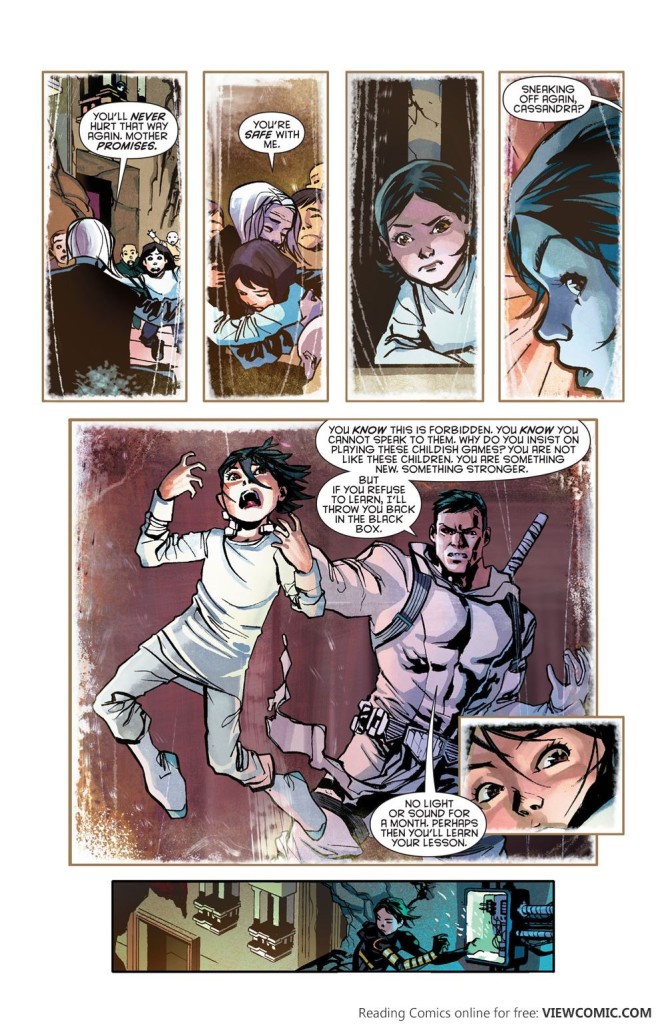 The scene can be read into as Tim’s own ignorance as to what Cass is really about, but only when relying on the fact that we know she used to be Batgirl in another life. For the new reader, Cassandra is Jeeja Yanin’s character from Chocolate, an autistic girl who fights like a freak of nature. Like with Batman’s newfound penchant for betrayal or Tim Drake’s newly assigned ego, it’s an understandable read of the character at first glance. But because the story doesn’t showcase subtleties in its characters, it remains hollow and in her case, near-the-knuckle racist.
The scene can be read into as Tim’s own ignorance as to what Cass is really about, but only when relying on the fact that we know she used to be Batgirl in another life. For the new reader, Cassandra is Jeeja Yanin’s character from Chocolate, an autistic girl who fights like a freak of nature. Like with Batman’s newfound penchant for betrayal or Tim Drake’s newly assigned ego, it’s an understandable read of the character at first glance. But because the story doesn’t showcase subtleties in its characters, it remains hollow and in her case, near-the-knuckle racist.
Story dictates character, so in issue #11 with Cassandra’s new origin the details surrounding her backstory remain both textually similar, but miss the trees for the fences. “Orphan” is revealed to be David Cain, her (by all intensive purposes) father who took her in privately and trained her in the art of body language-reading, utilizing the communication part of her brain. So far so good.
He also tried to teach her that “words are lies” and “only the body speaks the truth”, as well as attempting to bleed out any feelings of fear or sympathy towards death by having her witness him murder hundreds of people, including children, over and over again. Keeping her in isolation away from kids her age was also part of the indoctrinating process.
 This is the kind of faux EC Comics garbage that maintains comic books’ bad reputation; a Milleresque reinvention of a character’s background and motivations which substitutes emotions and pathos for uber-violence and histrionics. No sooner has a Batman comic offer up an opportunity for terrific modern-day satire. I prayed that was the case, for the creative team’s sake, as well as my own.
This is the kind of faux EC Comics garbage that maintains comic books’ bad reputation; a Milleresque reinvention of a character’s background and motivations which substitutes emotions and pathos for uber-violence and histrionics. No sooner has a Batman comic offer up an opportunity for terrific modern-day satire. I prayed that was the case, for the creative team’s sake, as well as my own.
It also denigrates David Cain, who in this continuity is merely a violent mook for “Mother” with no discernible personality other than an oedipal complex. His goals in raising Cassandra are as selfish as they always were, but there’s far less humanity in the guy, resulting in a devastatingly dull character.
 David Cain in the original continuity was someone whose own insane goals were balanced by a deep and genuine love for Cassandra as a daughter. A demonstration of this odd relationship can be found in Batgirl #8 (2000) when Batman views tapes of David training Cassandra. He would beat her, shoot her and sic assassins on her to increase her fighting skills, but those scenes were always accompanied by the two of them smiling and enjoying each other. The language restriction was a way for her to increase her fighting prowess, not from a fear of being lied to.
David Cain in the original continuity was someone whose own insane goals were balanced by a deep and genuine love for Cassandra as a daughter. A demonstration of this odd relationship can be found in Batgirl #8 (2000) when Batman views tapes of David training Cassandra. He would beat her, shoot her and sic assassins on her to increase her fighting skills, but those scenes were always accompanied by the two of them smiling and enjoying each other. The language restriction was a way for her to increase her fighting prowess, not from a fear of being lied to.
Cain’s a character whose engaging nature hasn’t survived much past Cassandra’s title. Later stories characterize pretty badly such as Robin and her miniseries, and while it’s easy to do the whole “angrily abusive parent” angle with him, that’s at the expense of a more vastly interesting character. It never rings true to who he was for the majority of his existence. The fact that Batgirl had both two loving father figures who expressed themselves in their own odd ways made Cassandra’s character more interesting whenever she had to choose a side. She always chose Batman, but it was never made easy since Cain never stopped loving her in his own way.
Which leads to the most important moment in Batman and Robin Eternal #13, in which we see her and Batman interact via flashback. It’s a brief scene where she re-enters Batman’s life. However unlike every other character in this title, Cass has the closest moment with Batman which culminates in a hug. It’s something that his other partners have yet to experience with him.
Oh yeah. Wait, how did that get there?
 So what we have here is a contradiction of character on Batman’s part, and a meaningful one at that. When it comes to Cassandra, the relationship between her and Batman has been unfailingly portrayed as a father – daughter dynamic, where the familial subtext reaches above ground the strongest since the days of the Silver Age between him and Dick. Out of all the relationships portrayed in the new 52 that came from the previous continuity (thus excluding the Bruce and Damian dynamic), this one rings the truest even if it’s only one brief scene.
So what we have here is a contradiction of character on Batman’s part, and a meaningful one at that. When it comes to Cassandra, the relationship between her and Batman has been unfailingly portrayed as a father – daughter dynamic, where the familial subtext reaches above ground the strongest since the days of the Silver Age between him and Dick. Out of all the relationships portrayed in the new 52 that came from the previous continuity (thus excluding the Bruce and Damian dynamic), this one rings the truest even if it’s only one brief scene.
But what does that do for the rest of the story surrounding Batman’s relationship with Mother, or the other Robins for that matter?
The scene between Bruce and Cassandra suggests that this story is meant to examine the innate contradictions in Bruce Wayne’s character. Her flashback is the first in the story that demonstrates Batman’s capacity for emotion, and with the scene taking place halfway through the announced lifespan of the series, one starts to think that the comic’s aspiration is to explore the different relationships between the Caped Crusader and his various wards. However with the fact that this is halfway through the series, the other suggestion is that any engagement in the subtext will have to be made in the preceding twelve issues. This is the Post-Flashpoint era, so there can’t be any looking back to the past in order to have the full scope of the story revealed. But because the current iteration of the universe is only four and a half years old and the continuity began in media res after six years, no amount of exploration will bring about any insight into what’s already been shown in the printed comics. So if the new history of Batman’s relationships with his Robins was meant to be imagined, then this was never going to be a series with any weight to it.
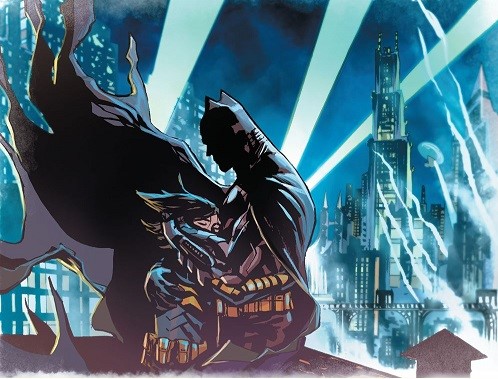 As of this writing, the story’s not over. Batman still has a chance to be redeemed, as do the writers. I actually enjoy this series more than I’m letting on despite everything about it. While the characterization is volatile, the worst part of Batman and Robin Eternal is by far the character of “Mother” and the concept of her “Nursery”. The B-movie badness of that whole idea wouldn’t be as offensively cynical if were played more for laughs, as though making sixties-esque Batman villains into horrific monsters isn’t in itself a further work of satire. But Dick Grayson serving as the main protagonist is fun to read. His character seems to come natural to James Tynion, and I like the fact that in Dick’s 75th anniversary he heads up a weekly series dedicated to all of Batman’s partners. It’s subtle enough to be really effective, and keeps the role of the good guys somewhat pure, even if he’s investigating Tim’s parents’ home behind the guy’s back.
As of this writing, the story’s not over. Batman still has a chance to be redeemed, as do the writers. I actually enjoy this series more than I’m letting on despite everything about it. While the characterization is volatile, the worst part of Batman and Robin Eternal is by far the character of “Mother” and the concept of her “Nursery”. The B-movie badness of that whole idea wouldn’t be as offensively cynical if were played more for laughs, as though making sixties-esque Batman villains into horrific monsters isn’t in itself a further work of satire. But Dick Grayson serving as the main protagonist is fun to read. His character seems to come natural to James Tynion, and I like the fact that in Dick’s 75th anniversary he heads up a weekly series dedicated to all of Batman’s partners. It’s subtle enough to be really effective, and keeps the role of the good guys somewhat pure, even if he’s investigating Tim’s parents’ home behind the guy’s back.
So at this point, “what is Batman and Robin Eternal about?”, and “how does it facilitate bringing back Cassandra Cain?”
The story’s about the many Batman partners that the fans love to see, which is why Cassandra’s finally present in the new 52. Like my review of Batgirl: Convergence, this is a situation where I have to ponder which matters more – character appearances or correct characterization. Despite everything, this series does better at characterizing Cassandra because the potential is still present for better stories. There’s nothing about her in this title that goes against her character, it’s just a matter of showcasing more of what she has to offer. That means more to me than the portrayal of Batman and Robin as that dynamic has enjoyed over seventy-five years of successful stories. Of course the series has another eleven issues to make good on that potential. For now however, the future looks bright, despite the cloudy sky.

